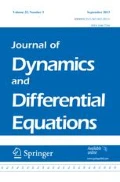Abstract
We consider planar central configurations of the Newtonian 2n-body problem consisting in two twisted regular n-gons of equal masses. We prove the conjecture that for \(n\ge 5\) all convex central configurations of two twisted regular n-gons are strictly convex.




Similar content being viewed by others
References
Barrabés, E., Cors, J.: On central configurations of twisted crowns. arXiv:1612.07135 (2016)
Chen, K.C., Hsiao, J.S.: Convex central configurations of the \(n\)-body problem which are not strictly convex. J. Dyn. Differ. Equ. 24, 119–128 (2012)
Fernandes, A., Garcia, B., Mello, L.: Convex but not strictly convex central configurations. J. Dyn. Differ. Equ. (2017). https://doi.org/10.1007/s10884-017-9596-0
Roberts, G.: Existence and stability of relative equilibria in the n-body problem. PhD thesis, Boston University (1999)
Saari, D.G.: Collisions, rings, and other Newtonian \(N\)-body problems, CBMS Regional Conference Series in Mathematics, vol 104. Published for the Conference Board of the Mathematical Sciences, Washington, DC; by the American Mathematical Society, Providence, RI (2005)
Yu, X., Zhang, S.: Twisted angles for central configurations formed by two twisted regular polygons. J. Differ. Equ. 253, 2106–2122 (2012)
Author information
Authors and Affiliations
Corresponding author
Additional information
This work has been realized thanks to the MINECO Grants MTM2016-80117-P and MTM2016-77278-P (FEDER) and Catalan (AGAUR) Grants 2017 SGR 1374 and SGR 1617.
Appendix
Appendix
1.1 Proof of Lemma 1
We want to prove that, for any fixed value \(a\in [\cos (\pi /7),1)\), the function
is positive in the closed interval \(u\in {{\mathscr {K}}}=\left[ u_m(a),\dfrac{3a}{b}\right] \), where \(b=\sqrt{1-a^2}\) and
The function T is clearly continuous and differentiable in the domain, so T must attain an absolute minimum on \({\mathscr {K}}\). On one hand, if we look for critical points in the interior of \({\mathscr {K}}\),
occurs at \(u_c=(3a+\sqrt{a^2+8})/(4b)\). It is not difficult to see that \(u_c<u_m\) for \(a\in [\cos (\pi /7),1)\), and \(\partial T/\partial u (a,u) >0\) for \(u\in [u_m,3a/b]\). Therefore, the minima of T occurs at \(u=u_m(a)\).
To conclude the proof it is enough to see that \(T(a,u_m(a))>0\). Simplifying, we want to see that
which is equivalent to prove that
Squaring both sides, the expression factors into
where p(x) is a polynomial of degree 13 with integer coefficients, which using Sturm’s Theorem contains no real zeros in the interval [9 / 10, 1].
1.2 Proof of Lemma 2
We want to prove that, for any fixed value of \(a\in [\cos (\pi /6),1)\), the function
is negative for any \(u\in {{\mathscr {K}}}=\left[ \dfrac{a}{b},u_m(a)\right] \), where \(b=\sqrt{1-a^2}\) and
The function is clearly continuous and differentiable in \({\mathscr {K}}\). On one hand, the function T(a, u) is strictly increasing with respect the variable u because
Therefore, \(T(a,u) \le T(a,u_m(a))\) and
Finally, it is not difficult to see that \(p'(a)\) has no roots in \(a\in [\cos (\pi /6),1]\) (for example, using Sturm’s theory) and \(p'(a)>0\). Therefore, \(T(a,u_m(a)) < p(1) =0\), which concludes the proof.
Rights and permissions
About this article
Cite this article
Barrabés, E., Cors, J.M. On Strictly Convex Central Configurations of the 2n-Body Problem. J Dyn Diff Equat 31, 2293–2304 (2019). https://doi.org/10.1007/s10884-018-9708-5
Received:
Published:
Issue Date:
DOI: https://doi.org/10.1007/s10884-018-9708-5



